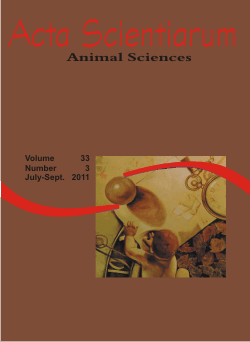<b>Utilização de complexo enzimático em rações para codornas de corte</b> - doi: 10.4025/actascianimsci.v33i3.11216
Resumo
Foram conduzidos dois experimentos com o objetivo de avaliar os efeitos da suplementação enzimática das rações à base de milho e farelo de soja sobre o desempenho e metabolizabilidade dos nutrientes em codornas de corte. Os tratamentos foram: controle positivo para atendimento das exigências; controle positivo suplementado com complexo enzimático e controles negativos suplementados reduzidos em 2 e 4% nos teores de energia metabolizável e aminoácidos. Na fase inicial, observou-se aumento no consumo de ração (p < 0,05) no tratamento controle negativo reduzido em 4% na energia metabolizável e aminoácidos em comparação aos tratamentos controle positivos. Na fase de crescimento o consumo de ração, conversão alimentar e rendimento de carcaça não diferiram (p > 0,05). Conclui-se que o complexo enzimático pode ser utilizado em dietas reduzidas em energia metabolizável e aminoácidos sem prejudicar o desempenho de codornas de corte. No ensaio de metabolismo, não foram observadas diferenças (p > 0,05) entre os tratamentos para os coeficientes de metabolização das matérias seca e orgânica, proteína bruta e energia bruta. O coeficiente de metabolização da FDN melhorou (p < 0,05) com a adição de enzimas.Downloads
DECLARAÇÃO DE ORIGINALIDADE E DIREITOS AUTORAIS
Declaro que o presente artigo é original, não tendo sido submetido à publicação em qualquer outro periódico nacional ou internacional, quer seja em parte ou em sua totalidade.
Os direitos autorais pertencem exclusivamente aos autores. Os direitos de licenciamento utilizados pelo periódico é a licença Creative Commons Attribution 4.0 (CC BY 4.0): são permitidos o compartilhamento (cópia e distribuição do material em qualqer meio ou formato) e adaptação (remix, transformação e criação de material a partir do conteúdo assim licenciado para quaisquer fins, inclusive comerciais.
Recomenda-se a leitura desse link para maiores informações sobre o tema: fornecimento de créditos e referências de forma correta, entre outros detalhes cruciais para uso adequado do material licenciado.








































